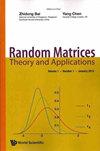非平稳高斯相关Wishart矩阵的高维状态
IF 0.6
4区 数学
Q4 PHYSICS, MATHEMATICAL
引用次数: 2
摘要
我们研究了相关Wishart矩阵的高维渐近状态[公式:见文],其中[公式:见文]是一个具有相关和非平稳条目的高斯随机矩阵。我们证明了在不同的归一化下,当[公式:见文]和[公式:见文]增长到无穷大时,会出现两个不同的区域。第一个区域是中心收敛区域,适当重整的Wishart矩阵在Wasserstein距离上接近于高斯正交系综矩阵的Wasserstein距离。在第二种状态下,发生非中心收敛,并且标准化Wishart矩阵的定律在Wasserstein距离上接近于Nourdin和Zheng最近引入的所谓Rosenblatt-Wishart矩阵的定律。然后,我们继续证明上述收敛性在函数设置中也成立,即在[公式:见文本]中的弱收敛性。作为我们的主要结果(在中心收敛区)的一个应用,我们表明它可以用来证明Wishart矩阵的经验谱分布对半圆定律的收敛期望。我们的发现补充和扩展了关于高斯Wishart矩阵波动研究的丰富结果集合,并且我们提供了基于双分数或次分数布朗运动的归一化增量给出的高斯条目的显式示例。本文章由计算机程序翻译,如有差异,请以英文原文为准。
High-dimensional regimes of non-stationary Gaussian correlated Wishart matrices
We study the high-dimensional asymptotic regimes of correlated Wishart matrices [Formula: see text], where [Formula: see text] is a [Formula: see text] Gaussian random matrix with correlated and non-stationary entries. We prove that under different normalizations, two distinct regimes emerge as both [Formula: see text] and [Formula: see text] grow to infinity. The first regime is the one of central convergence, where the law of the properly renormalized Wishart matrices becomes close in Wasserstein distance to that of a Gaussian orthogonal ensemble matrix. In the second regime, a non-central convergence happens, and the law of the normalized Wishart matrices becomes close in Wasserstein distance to that of the so-called Rosenblatt–Wishart matrix recently introduced by Nourdin and Zheng. We then proceed to show that the convergences stated above also hold in a functional setting, namely as weak convergence in [Formula: see text]. As an application of our main result (in the central convergence regime), we show that it can be used to prove convergence in expectation of the empirical spectral distributions of the Wishart matrices to the semicircular law. Our findings complement and extend a rich collection of results on the study of the fluctuations of Gaussian Wishart matrices, and we provide explicit examples based on Gaussian entries given by normalized increments of a bi-fractional or a sub-fractional Brownian motion.
求助全文
通过发布文献求助,成功后即可免费获取论文全文。
去求助
来源期刊

Random Matrices-Theory and Applications
Decision Sciences-Statistics, Probability and Uncertainty
CiteScore
1.90
自引率
11.10%
发文量
29
期刊介绍:
Random Matrix Theory (RMT) has a long and rich history and has, especially in recent years, shown to have important applications in many diverse areas of mathematics, science, and engineering. The scope of RMT and its applications include the areas of classical analysis, probability theory, statistical analysis of big data, as well as connections to graph theory, number theory, representation theory, and many areas of mathematical physics.
Applications of Random Matrix Theory continue to present themselves and new applications are welcome in this journal. Some examples are orthogonal polynomial theory, free probability, integrable systems, growth models, wireless communications, signal processing, numerical computing, complex networks, economics, statistical mechanics, and quantum theory.
Special issues devoted to single topic of current interest will also be considered and published in this journal.
 求助内容:
求助内容: 应助结果提醒方式:
应助结果提醒方式:


